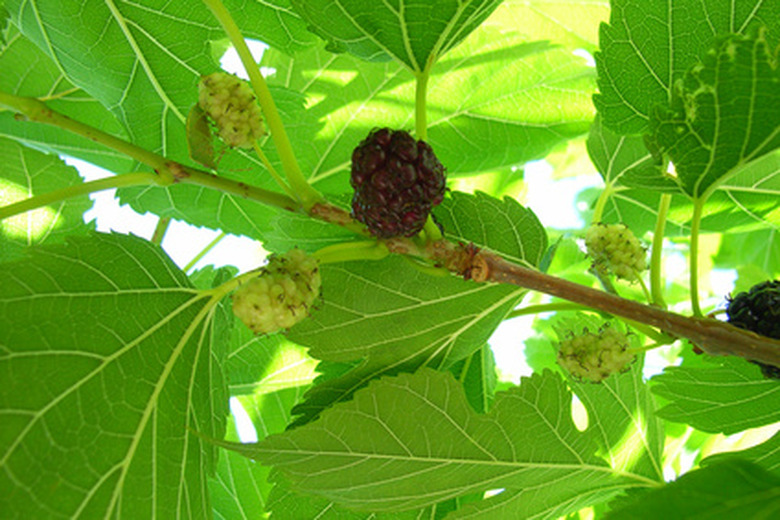What Kind Of Fertilizer Does A Mulberry Tree Need?
Native red mulberry trees are prized as "homestead" trees because of their generous shade and tasty blackberry-like fruits. They do best in moist, well-drained soil, yet tolerate a wide range of soil types. The red or American mulberry, Morus rubra, is drought-tolerant and almost unfazed by air pollution and pests. Other cultivated mulberries include the white mulberry, M. alba, brought to the U.S. in the 1700s, and the small black mulberry, M. nigra.
Mulberry
Now that fewer people live on farms, the classic red mulberry tree, Morus rubra, has dropped in popularity. It's a great tree for the pasture but not good in small yards. Ripe purple-black fruits are excellent in jams and syrups, and popular with songbirds, squirrels and raccoons. But they make quite a mess, staining sidewalks and driveways and damaging paint on cars. For fruit lovers, many new cultivars are available. Fruitless white mulberries are viable urban or suburban tree options.
Fertilizer
Mulberry trees are fast growing, vigorous trees that require little fertilization. According to California Rare Fruit Growers, an annual application of a fertilizer with balanced amounts of nitrogen, phosphate and potash, such as 10-10-10, will maintain satisfactory growth. According to North Carolina Cooperative Extension, it's best to fertilize with 10-10-10 fertilizers twice each year–once in late winter and again in mid-summer–by applying one pound per every inch of trunk diameter. Just Fruits & Exotics of Crawfordville, Florida recommends using organic fertilizers such as Espoma Citrus Tone, especially for the micronutrients provided, and fertilizing three times of year in southern climates–in February, May and late July–and twice each year in northern areas.
Considerations
In California mulberries usually need only nitrogen, according to California Rare Fruit Growers. The only way to know for certain if soil has adequate amounts of phosphorous, potassium and other nutrients and micronutrients is to get a comprehensive soil test done through your local country extension service. You may also want to adjust fertilizer amounts if you're using mulberries for a purpose other than fruit or shade tree. Mulberries grown closely together and pruned frequently make excellent hedges, for example, but probably need less fertilizer.
Application
Never apply fertilizer after August, to avoid stimulating tender new growth that may be damaged by cold winter temperatures. Spread fertilizer evenly beneath the tree of hedge canopy, but avoid applying fertilizer within two inches of each trunk. For organic fertilizers, which require interaction with soil to effectively break down nutrients for plant use, scratch fertilizer lightly into the soil's surface inch or so, using a hoe or hand cultivator. Irrigate thoroughly.
Overuse
Don't overuse fertilizer, or apply nutrients that aren't needed. Mulberry trees are generally quite wind-resistant, with some cultivars used as windbreaks. But overusing fertilizers can cause mulberries to grow too fast and may weaken wood. Using too much fertilizer–or fertilizer elements that aren't needed–can cause environmental problems too, such as pollution of groundwater supplies, streams and lakes. This is especially true of excess nitrogen and phosphorous.
